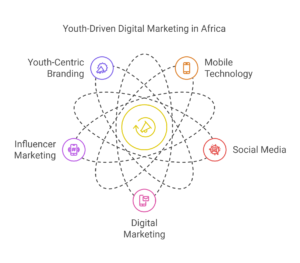Africa’s population is undergoing rapid changes that are transforming consumer markets. Factors such as population growth, urbanization, and a youthful age structure are creating new demands, while the rising economic influence of women and the expanding middle class are shaping product and service preferences across the continent. These shifts present significant opportunities for businesses to innovate and capture a growing and diverse consumer base.
Understanding the demographic changes that are likely to unfold over the coming years, as well as the challenges and opportunities that they present for achieving sustainable development, is key to the design and implementation of the new development agenda,” said Wu Hongbo, UN Under-Secretary-General for Economic and Social Affairs.
Africa’s Rapid Population Growth and its Economic Implications
- Data: The United Nations projects stated that by 2050, Africa’s population will reach close to 2.5 billion. Such a figure would mean that more than 25 percent of the world’s population will be African. Its population growth will slow thereafter, but Africa will remain by far the largest source of growth globally: its share of the world’s population is set to reach close to 40 percent by the end of the century.
- Impact on Markets: This unprecedented growth expands the consumer base for essential goods such as food, housing, healthcare, and education. Sectors that cater to these needs are poised for tremendous growth. In 2010, there were 50 urban agglomerations in Africa with a population of one million or more, of which three had a population of five million or more. By 2025, the UN expects there to be 93 agglomerations in Africa of at least one million, of which 12 are forecast to have a population of five million or more. Nigeria accounts for around a quarter of these (in terms of the number of agglomerations, not the population size). Cairo was the 18th largest urban agglomeration in the world in 2010 (11 million), while Lagos (10.8 million) was the 20th largest. By 2025, Lagos is expected to move up to the 11m position globally, with Cairo falling by one position.
The Fast-Moving Consumer Goods (FMCG) sector has seen exponential growth across Africa. In Nigeria, this expansion is driven by factors such as the rising income of the middle-class sector, urban expansion, and increasing health awareness among consumers. These factors have collectively fueled the demand for consumer packaged goods, with FMCG companies responding to these evolving trends. The industry is projected to be worth $38 billion by 2024, with market size reaching $23 billion in 2023, highlighting rapid growth.
Urbanization and the Rise of Mega-Cities
- Data: By 2030, urbanization rates in Nigeria, Tanzania, Ethiopia, and Angola are expected to exceed 50%. Lagos, for instance, is one of Africa’s largest and fastest-growing mega-cities, with a population ranging between 13 to 27 million. The city has an annual growth rate of 3.2%, which surpasses Nigeria’s national growth rate of 2.6%. Lagos is projected to become the world’s most populous city by 2100, reaching an estimated 88.3 million people. Its urban expansion is not only concentrated in the metropolitan area but also spreading to peripheral regions, including parts of neighboring states like Ogun State and reclaimed areas like Epe, Badagry, and Ibeju-Lekki Local Government Areas.
- Changing Consumer Behaviour: As urbanization accelerates, the rise of middle-class consumers with higher disposable incomes creates opportunities for premium goods and diverse services. These consumers demand more convenience and are adopting modern shopping habits such as e-commerce and mobile payments.
- Focus on Urban Youth: Africa’s youth are driving tech adoption. For example, the mobile payment platform M-Pesa has seen widespread use in Kenya, largely among younger, urban consumers, who are increasingly digital-first in their spending habits.
- New Trends: Urbanization is reshaping retail, entertainment, and food consumption. Rapid delivery services, fast food outlets, and modern retail experiences (such as online shopping) are becoming more popular, particularly in cities like Lagos,Nairobi and Johannesburg.
The Shifting Age Structure – A Growing Youthful Population
- Impact on Technology and Digital Marketing: Africa has the youngest population in the world, with 70% of sub-Saharan Africa under the age of 30. This demographic is driving the proliferation of mobile technology, social media, and digital marketing. Businesses are increasingly targeting this audience through influencer marketing and youth-centric branding. (Blog post 7 :The Rise of Mobile-First Marketing in Africa: A Game Changer for African Businesses)
- Implications for Businesses: Companies that invest in mobile-first strategies are seeing significant growth. For example, the rise of mobile apps and digital services in Nigeria has created new platforms for brands to engage with tech-savvy youth. By aligning branding with youth culture, businesses can capture this influential market.

The Rise of Women as Key Economic Drivers
Women’s economic empowerment is reshaping sectors such as fashion, health, and e-commerce. According to the World Economic Forum, women make up 58% of Africa’s self-employed population and contribute around 13% to the continent’s GDP. Sub-Saharan Africa has the highest global rate of female entrepreneurial activity at 26%. These female-led businesses are not only as profitable as male-led startups but are also more likely to drive social impact and empowerment across the continent.
Migration Patterns and Regional Market Variations
According to African Migration Trends to Watch in 2024, migration across the African continent continues to rise, driven by economic challenges, political instability, and climate change. This has led to approximately one million new migrants annually, contributing to a total of 43 million African migrants. Most of these migrants are young and single, seeking employment opportunities within urban areas. As a result, migration has diversified the consumer base across Africa, with varying preferences shaped by cultural, regional, and economic factors. Migrants moving to urban hubs bring new consumption patterns, demanding products and services that reflect their diverse backgrounds and needs.
Migration and Diaspora Influence in Africa as a Demographic Shift Impacting Consumer Trends
The migration and diaspora influence on African consumer trends is profound and multifaceted. Diaspora led e-commerce platforms are reshaping the retail landscape in Africa. MallforAfrica, one of the platforms that bridges the gap between African consumers and international retailers by offering access to billions of products previously out of reach for many. Over the years, it has established itself as a leader in African e-commerce, tapping into the demand for international goods that diaspora communities often enjoy abroad. as a platforms they reflect the growing influence of the diaspora in expanding consumer choices and improving access to international products, making global brands more accessible to African consumers.
Embracing the Future of African Consumer Trends
As Africa continues to experience rapid demographic changes, businesses that adopt data-driven, innovative strategies will remain competitive in this evolving market, by capitalizing on trends such as urbanization, youth-driven technology adoption, and the economic rise of women and the middle class, businesses can build a sustainable presence in the continent’s growing economy.




